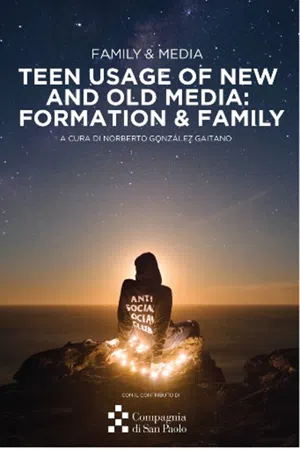
- 176 pages
- English
- ePUB (mobile friendly)
- Available on iOS & Android
Teen Usage of New and Old Media: Formation & Family
About this book
Questa ricerca vuol essere uno spunto di riflessione sul tema del rapporto tra tecnologia e adolescenza in particolare per gli insegnati, gli educatori, i genitori, gli operatori sociali, tutte le associazioni e le istituzioni che si occupano di ricerca e formazione giovanile. Il nostro suggerimento è di andare oltre i dati numerici, certamente utili e indicativi, per coglierne l'essenza e lo spirito. Non pensate ad una ricerca che offra tabelle, grafici, statistiche e percentuali. Immaginatevi, piuttosto, dei ragazzi in carne ed ossa che, con spontaneità ed entusiasmo, vi raccontano qualcosa di loro e del proprio modo di vedere la vita. Lo scopo? Pensare e ispirare programmi educativi che nascano proprio dal confronto con questi giovani.Il progetto di ricerca Famiglia e media è un'iniziativa internazionale portata avanti dai diversi dipartimenti delle Università: Pontificia della Santa Croce (Roma), Cattolica del Sacro Cuore (Milano), della Svizzera italiana (Lugano), Austral (Buenos Aires), CEU San Pablo (Madrid e Valencia), Cattolica de Argentina (Buenos Aires), Sacra Concezione (Concepción, Cile).Norberto González Gaitano (Alcaraz, Spagna). Professore Ordinario di Opinione Pubblica e docente di Etica della Comunicazione presso la Pontificia Università della Santa Croce. Autore di Famiglia e Media. Relazioni familiari, le loro rappresentazioni sui mezzi di comunicazione e relazioni virtuali (2015), Famiglia e media. Associazioni familiari e comunicazione (2011), Public Opinion and the Catholic Church (2010), Famiglia e media. Il detto e il non detto (2008), Comunicazione e luoghi della fede (2000), La interpretación y la narración periodísticas (1997) e El deber de respeto a la intimidad (1990). Già professore di Etica della comunicazione presso l'Università della Laguna (Spagna, 1990-1996) e docente di Etica giornalistica presso l'Università di Navarra (Spagna, 1981-1990); Visiting Research Scholar di The University of Chicago (2008-2009) e di The Catholic University of America (Washington, 1995). Direttore del progetto di ricerca Famiglia e media (www.familyandmedia.eu), esperto del AVEPRO (Agenzia della Santa Sede per la Valutazione e la Promozione della Qualità delle Università e Facoltà Ecclesiastiche) e Consultore del Pontificio Consiglio delle comunicazioni sociali.
Frequently asked questions
- Essential is ideal for learners and professionals who enjoy exploring a wide range of subjects. Access the Essential Library with 800,000+ trusted titles and best-sellers across business, personal growth, and the humanities. Includes unlimited reading time and Standard Read Aloud voice.
- Complete: Perfect for advanced learners and researchers needing full, unrestricted access. Unlock 1.4M+ books across hundreds of subjects, including academic and specialized titles. The Complete Plan also includes advanced features like Premium Read Aloud and Research Assistant.
Please note we cannot support devices running on iOS 13 and Android 7 or earlier. Learn more about using the app.
Information
Capitolo 1- Teen Usage of New and Old Media: Formation & Family
1 http://jubileecentre.ac.uk/1617/papers/seminar-papers.
Table of contents
- Indice
- PREFAZIONE
- Capitolo 1- Teen Usage of New and Old Media: Formation & Family
- Capitolo 2 - Videogiochi e adolescenti: istigazione alla violenza o educazione?
- Capitolo 3 - Fruizione giovanile delle reti sociali
- Capitolo 4- Discutere su amore e amicizia con i ragazzi a partire di una fiction giovanile, Braccialetti rossi